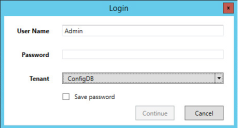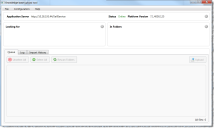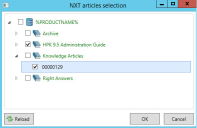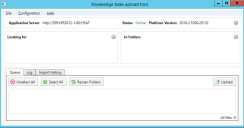Service Manager
Importing Knowledge Articles from Other Systems Using the Knowledge Uploader (Knowledge Import Tool)
This topic only applies to Service Manager on-premise customers. It does not apply to Service Manager Cloud customers.
•About the Knowledge Uploader (Knowledge Import Tool)
•About Installing the Knowledge Uploader (Knowledge Import Tool)
•Initially Configuring and Logging Into the NXT Knowledge Import Tool
•Using the NXT Knowledge Import Tool
•Initially Configuring and Logging Into the Knowledge Import Tool
•Using the Knowledge Import Tool
About the Knowledge Uploader (Knowledge Import Tool)
You can import knowledge articles from Ivanti Classic, ITSM, or a local or networked file application into Service Manager. Service Manager currently has two knowledge import tools: the Knowledge Import Tool NXT (for NXT formats such as ITSM or Ivanti Classic) and the Knowledge Import Tool (to use with file systems). These tools are collectively called the Knowledge Uploader and are also called the Knowledge Import Tool.
About Installing the Knowledge Uploader (Knowledge Import Tool)
When you install Service Manager, one of the components that you can choose to install is the Knowledge Uploader (also called the Knowledge Import Tool).
For complete information about installing Service Manager, including the Knowledge Uploader (also called the Knowledge Import Tool), see the Installation and Deployment Guide for Ivanti Service Manager.
Initially Configuring and Logging Into the NXT Knowledge Import Tool
There are two knowledge tools. This topic is about the NXT Knowledge Import Tool and NOT the Knowledge Import Tool.
After you have installed Ivanti, including the Knowledge Uploader (also called the Knowledge Import Tool), do the following to initially configure and log into the Knowledge Import Tool NXT:
1.On the application where you installed Ivanti Service Manager, open the application called Knowledge Import Tool NXT. The application displays the NXT Knowledge Server Configuration dialog box.
NXT Knowledge Server Configuration Dialog Box
2.Enter information into the fields.
| Parameter | Description |
|---|---|
| Server Version |
The version of the NXT server that you are taking the knowledge articles from. To determine the server version, open the program and find the server information.
You can choose from any of the following: Knowledge Service V5.0.4003.3 Knowledge Service Plus V9.6.1.13 Knowledge Service Plus V9.6.1.14 |
| Server Address |
Enter the following: The protocol type (uses TCP by default) The server path of the NXT server that you are taking the knowledge articles from The port (uses 2242 by default) |
| User Name | The user name of a person who can access the NXT server that you are taking the knowledge articles from. |
| Password | The password associated with the user name. |
| Save password | Saves the password. |
To change these settings after the initial configuration, from the menu bar select Configuration > Configure NXT server.
3.Click Continue.
4. The application displays the Login dialog box.
Knowledge Server Tool Login
5.Enter information into the fields.
| Parameter | Description |
|---|---|
| User Name | The user name of a person who can access Ivanti Service Manager. |
| Password | The password associated with the user. |
| Tenant | The tenant to log into. You can select either ConfigDB to log into the configuration database or HEATSM to log into Ivanti Service Manager. |
| Save password | Saves the password. |
To change these settings after the initial configuration, from the menu bar select Configuration > Configure application server.
6.Click Continue. The application displays the Select role dialog box.
7.Select the role to log in as and click Continue. The application displays the Knowledge base upload tool page.
Knowledge Base Upload Tool
Using the NXT Knowledge Import Tool
There are two knowledge tools. This topic is about the NXT Knowledge Import Tool and NOT the Knowledge Import Tool.
Follow these steps to import knowledge into Ivanti Service Manager.
1.Click Select Articles to select the knowledge articles to import. The application displays the NXT articles selection dialog box.
2.Expand the list to see where knowledge articles are located, and then highlight one or more articles.
Select the Knowledge Articles to Import
3.Click OK. The application lists the selected articles on the bottom part of the page.
4.Select the articles to upload and click Upload to launch the Article Creation wizard and start the upload process.
The Article Creation wizard page contains two main areas: a Selected Documents area on the left containing the list of files to import, and a Document Properties area on the right that contains two tabs. One tab is called Default Values and the other is called Selected Documents.
5.To remove a document from the Selected Documents section, check it and click Remove selected. By default, the knowledge uploader imports all of the documents in the Selected Documents, even if you do not select them.
6.Optionally, use the Document Properties section to specify the properties that the knowledge uploader displays together with the files in Ivanti Service Manager. You can specify properties for all files (using the Default values tab) or for individual files (using the Selected Document tab after highlighting the file in the Selected Documents section).
You can specify these properties:
•Article Type: The article type. Select from Document, Error Message, Issue Resolution, Patch, Q&A, or Reference.
•Article Status: The status of the article. Select from Approved, Draft, Expired, Failed Review, Pending Review, Published, or Submitted.
•Target collection: The target. Select from Company Policy & Procedure, Customer Knowledge, Internal Knowledge, IT Knowledge, or Service Desk.
•Category: The category for this knowledge article.
•Subject: The subject of the article.
•Resolution: The resolution details if the knowledge article contains this information.
•Description: A description for the knowledge article.
7.Click Import. The application starts importing the selected knowledge articles.
If you select a file that has already been imported into the knowledge base, the application displays the Collision warning dialog box.
8.Depending on what you want to do with the file that has already been imported, click one of the following:
•Apply for all: Applies your choice to all previously imported files that are found during the import process.
•Update: Overwrites the file that already exists in the Knowledge Base with the file that is being imported.
•Create New: Does not overwrite the file being imported with the file that already exists in the Knowledge Base. After importing, there are two knowledge articles with the same name in the Knowledge Base.
•Cancel: Cancels the import process.
The application displays a dialog box with the status of the import.
9. Click OK.
10.Optionally, do the following:
•Review the import logs by clicking the Log tab. You can clear or save the log.
•Review the import history by clicking the Import History tab. Click a number in the Imported column to display more information about an import session.
Initially Configuring and Logging Into the Knowledge Import Tool
There are two knowledge tools. This topic is about the Knowledge Import Tool and NOT the NXT Knowledge Import Tool.
After you have installed Ivanti Service Manager, including the Knowledge Uploader (also called the Knowledge Import Tool), do the following to initially configure and log into the Knowledge Import Tool:
1.On the application where you installed Ivanti Service Manager, open the application called Knowledge Import Tool. The application displays the Select role dialog box.
2.Select the role to log in as and click Continue. The application displays the Knowledge base upload tool page.
Knowledge Base Upload Tool
Using the Knowledge Import Tool
There are two knowledge tools. This topic is about the Knowledge Import Tool and not the NXT Knowledge Import Tool.
Follow these steps to import knowledge into Ivanti Service Manager.
1.Specify the article file type to search for, by doing the following:
| a. | Click the Settings icon  in the Looking for section. The application displays the File search filters dialog box. in the Looking for section. The application displays the File search filters dialog box. |
| b. | In the Add New drop-down list, select one or more file types: |
•Microsoft office documents: Files that have .doc, .docx, .xls, and .xlsx extensions.
•PDF files: Files that have a .pdf extension.
•Images: Files that have .bmp, .jpg, and .gif extensions.
| c. | Optionally, you can add more file types by clicking Custom. The application adds a line item to the filter list called Custom. Click the line item to open it for editing. You can change the filter name and specify one or more extensions. Click OK. The application adds the file types that you specified to the Looking for section. |
2.Specify which local or network folders to search for knowledge articles and then perform the search:
| a. | Click the Settings icon  in the In Folders section. The application displays the Import folders dialog box. in the In Folders section. The application displays the Import folders dialog box. |
| b. | Click Add New. The application displays the Browse For Folder navigation dialog box. |
| c. | Navigate to a folder and highlight it. (To optionally add a new subfolder to the folder, click Make New Folder.) |
| d. | Click OK. The application adds the folder to the list of folders to search. If you created a new folder, the application adds it to the file application as an empty folder. |
| e. | Optionally, check Recursive for a folder to specify that the application should search the subfolders within the folder. |
| f. | Optionally, check Monitor for changes to configure the knowledge uploader to monitor all of the folders on the list for changes to the file types that you specified in step 1b. |
| g. | Repeat steps b-f to continue to add folders to the list as necessary. |
| h. | Click OK. |
The knowledge uploader performs the search and displays all of the files that meet the search criteria.
3.Select the files to upload:
| a. | If you think the contents of the scanned folders might have changed, click Rescan Folders to regenerate the file list. |
| b. | In the file list, check the files to upload, or click Select All to upload all of the files. |
| c. | Click Upload to launch the Article Creation wizard and start the upload process. |
The Article Creation wizard page contains two main areas: a Selected Documents area on the left containing the list of files to import, and a Document Properties area on the right that contains two tabs. One tab is called Default Values and the other is called Selected Documents.
4.To remove a document from the Selected Documents section, check it and click Remove selected. By default, the knowledge uploader imports all of the documents in the Selected Documents, even if you do not select them.
5.Optionally, use the Document Properties section to specify the properties that the knowledge uploader displays together with the files in Service Manager. You can specify properties for all files (using the Default values tab) or for individual files (using the Selected Document tab after highlighting the file in the Selected Documents section).
You can specify these properties:
•Article Type: The article type. Select from Document, Error Message, Issue Resolution, Patch, Q&A, or Reference.
•Article Status: The status of the article. Select from Approved, Draft, Expired, Failed Review, Pending Review, Published, or Submitted.
•Target collection: The target. Select from Company Policy & Procedure, Customer Knowledge, Internal Knowledge, IT Knowledge, or Service Desk.
•Category: The category for this knowledge article.
•Use file name as Subject: Check to use the article file name to fill in the Subject field.
•Subject: Only use this field if you did not check Use file name as Subject. Enter a subject for the article.
•Resolution: Enter the resolution if the knowledge article contains one.
•Description: Enter a description for the knowledge article.
6.Click Import. The import process begins.
If you select a file that has already been imported into the knowledge base, the application displays the Collision warning dialog box.
7.Depending on what you want to do with the file that has already been imported, click one of the following:
•Apply for all: Applies your choice to all previously imported files that are found during the import process.
•Update: Overwrites the file that already exists in the knowledge base with the file that is being imported.
•Create New: Does not overwrite the file being imported with the file that already exists in the knowledge base. After importing, there are two knowledge articles with the same name in the knowledge base.
•Cancel: Cancels the import process.
The application displays an Import dialog box with the status of the import.
8. Click OK.
9.Optionally, do the following:
•Review the import logs by clicking the Log tab. You can clear or save the log.
•Review the import history by clicking the Import History tab. Click a number in the Imported column to display more information about an import session.
Was this article useful?
Copyright © 2019, Ivanti. All rights reserved.




